Building a High-Performance Culture and Cultivating Community with Stacey Porter from Procept BioRobotics
Andy Storch recently welcomed Stacey Porter, Chief People Officer at Procept BioRobotics, back to the Talent Development Hot Seat Podcast for an inspiring conversation on building a high-performance culture and cultivating a sense of community within a fast-growing organization. Drawing on both her broad HR experience and lessons learned from leading talent development in high-growth and mature companies alike, Porter shared actionable strategies for designing intentional cultures, developing leaders, and increasing career mobility. Here’s how you can apply these proven tactics to foster excellence and belonging in your own organization.
Design Culture with Purpose
Porter observed that every organization, intentionally or not, ends up with a culture—it’s either shaped or left to default. To move beyond the status quo, treat culture as a product that you co-create with your team. Start by articulating what makes your organization unique: the language people use, the stories they tell, and the rituals they value. Invite input at every level. Allow employees to leave their fingerprints on your culture by making it flexible and participatory, not static or prescriptive.
Empower Teams to Own Decisions
Empowering employees and teams with real authority is central to a high-performance culture. As Porter emphasized, individuals and teams closest to the action should be trusted to make key decisions within their domain. This empowers faster problem-solving, enhances accountability, and attracts top talent who want autonomy to drive meaningful outcomes. Leaders must actively support these decentralized decisions and provide a safety net when teams take calculated risks.
Develop Conversationally Competent Managers
Leadership development at Procept BioRobotics focuses on practical skills delivered through their Spark Management Development Program. Porter’s approach centers around building “conversational competence” in managers by honing three core conversations:
- Priorities: Helping managers and their teams differentiate between what’s urgent, important, or can be deferred—providing clarity, direction, and managing workload effectively.
- Performance: Encouraging straightforward, continuous feedback with an emphasis on “more of this, less of that,” making feedback actionable and non-bureaucratic.
- Growth: Fostering career conversations that support each employee’s development—whether that means deepening existing skills or exploring new strengths—instead of hoarding talent within a single team.
Structure Leadership Development for Impact
The Spark program is intentionally designed for all people managers, regardless of level or function, fostering cross-functional learning and collaboration. Each cohort participates in an executive spotlight discussion, followed by a two-day immersive, in-person experience. This is complemented by targeted electives on topics like hiring for culture fit, running high-performing teams, and managing underperformance. Participation is incentivized: the first to complete pre-work secure a spot in the next cohort, harnessing the company’s intrinsic drive for self-improvement.
Utilize Language and Rituals to Cement Culture
Pay close attention to the language used across the company, as it is a leading indicator of cultural health. Catchphrases and rituals—like “bad news early” or “first teams first”—become part of your culture code and guide day-to-day behaviors that reinforce shared values. As Porter noted, when language and behaviors are aligned, they create repeatable rituals and ultimately, lasting culture.
Drive Career Mobility and Talent Flow
Porter champions the concept of “talent flow”—viewing career development as a dynamic journey both within and across teams. At Procept BioRobotics, career conversations, visible mobility opportunities, and active internal recruitment have nearly doubled internal mobility rates and reduced turnover. Where possible, prioritize growing from within and destigmatize cross-team moves. This not only increases retention but deepens organizational capability and engagement.
Foster Community and Connection
Connection is a key driver of engagement and performance. Procept hosts community-building activities ranging from Slack channels organized by personal interests, to informal gatherings, leadership communities, and celebratory milestones. Porter advocates for supporting informal interactions as much as formal ones—small acts like sharing a meal or casual “wine and cheese” events go a long way in creating belonging and psychological safety.
Measure and Sustain Success
Build-in multiple ways to assess the impact of your talent and development efforts: engagement survey responses on managerial investment, participation in performance reviews, and trends in retention and average tenure. Look for upward movement in indicators like “my manager is invested in my success” on engagement surveys, and recognize exceptional managers to celebrate and reinforce strong practices.
Apply Fresh Eyes to Old Systems
Finally, be willing to reexamine traditional organizational structures, like goal alignment and information flow, with fresh perspectives. Don’t be afraid to experiment with new approaches, whether it’s how teams are set up or how you reward performance, to match the current needs of your evolving culture.
Building a high-performance culture is a deliberate, ongoing process. By embracing these strategies—intentional design, empowered leadership, conversational competence, mobility, and deep connection—you can help your organization and its people thrive, today and into the future.
Be sure to listen to the full episode with Stacey Porter on the Talent Development Hot Seat Podcast for even more actionable insights!
Stacey Porter is the Chief People Officer at Procept BioRobotics and an accomplished HR leader passionate about developing impactful leaders, designing forward-thinking talent programs, and building vibrant, connected communities at work. Her innovative, people-first strategies have shaped cultures and driven success in both Fortune 500 companies and high-growth startups alike.

